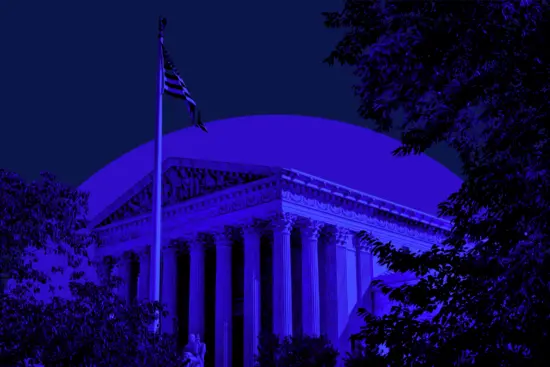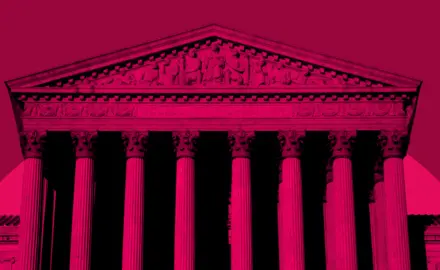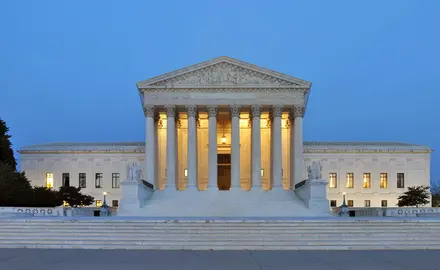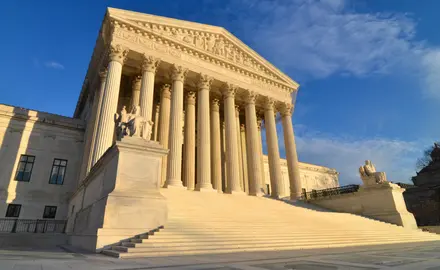
We're fighting for a fair and equitable Supreme Court
From abortion access to voting rights, we've seen our freedoms systematically stripped away by the current incarnation of the Supreme Court. At the same time, the stacked Court isn't hiding its bias toward Trump and his agenda. We must fight back! Together, we can correct the course of the Supreme Court, ensure ethics rules are put in place to hold justices accountable, and expand the Court to return fairness and equality to the highest Court in the land.

Another Dangerous Term at the Supreme Court
Because of the far-right extremists on the Court, we have lost our constitutional right to abortion care. Affirmative action in higher education. Environmental protections. And they've weakened laws protecting us from discrimination.
This term, the Court could make things even worse.
Issue by issue, we broke down what's at stake this Supreme Court term - and how this Court ruled
In the Supreme Court’s notorious 2022 Dobbs decision, the 6-3 ultra-conservative majority took away our constitutional right to abortion care. Now the Court is considering two cases that may restrict access to abortion even more. One case may limit access to a widely used method of medication abortion. The other may limit access to urgently needed abortion care during medical emergencies.

The mifepristone case: Food and Drug Administration (FDA) v. Alliance for Hippocratic Medicine
After Dobbs, conservatives targeted the availability of medication abortion. They created an organization called the Alliance For Hippocratic Medicine to manufacture a lawsuit against the FDA, falsely claiming that mifepristone is unsafe - contrary to all available research evidence.
The anti-abortion forces made sure to get their case before a judge who would ignore science, facts, and the law: So they incorporated themselves in Amarillo, Texas, which has only one federal judge: Matthew Kacsmaryk.
The lawsuit should have been dismissed even before a judge considered the merits. That’s because of a constitutional requirement called standing: In order to sue in a federal court, you have to show some kind of injury. You can’t go to federal court just because you disagree with something. You actually have to have an injury that the court can remedy.
On June 13th, 2024, the Supreme Court dismissed the lawsuit targeting FDA approval of mifepristone, preserving access to the medication for the immediate future.
Get the background More on the Supreme Court's decision
The emergency abortion care case: Moyle v. United States
Moyle v. United States is about far-right efforts to deny abortion care even in emergency situations when it’s needed to protect a patient’s health. In 1986, Congress passed the Emergency Medical Treatment and Labor Act (EMTALA). Congress acted because hospitals were turning away people who needed emergency medical care. EMTALA requires hospitals receiving Medicare (which most do) to provide stabilizing medical care when there is an emergency.
Sometimes, when someone who is pregnant has severe complications, the safest way to protect their health is to provide an abortion. But anti-abortion forces are trying to prevent that care from being given, claiming EMTALA does not require emergency abortion care.
This term, the Supreme Court is considering two challenges to laws seeking to stem gun violence. United States v. Rahimi will affect whether we can keep guns out of the hands of domestic abusers. And Garland v. Cargill will determine if the federal ban on machine guns includes firearms that are built differently but are just as lethal.

United States v. Rahimi
Under the Violence Against Women Act, it's illegal for someone subject to a domestic violence restraining order to possess a gun or ammunition. But in 2022, the Supreme Court established that judges can only uphold a firearms regulation if a comparable law existed at the time the Second or Fourteenth Amendments were adopted. Now, gun safety laws that were upheld in the past are under attack.
On June 21st, 2024, the Supreme Court upheld a common-sense statute that nobody who is subject to a domestic violence restraining order should be allowed to have a gun.
Get the background Read the Supreme Court's decision
Garland v. Cargill
Garland v. Cargill is about how to interpret a gun safety statute: the federal ban on possessing machine guns. It does not involve the Second Amendment. The Court will decide if the federal ban on machine guns includes a gun that works differently mechanically but still shoots hundreds of rounds in a minute just like a machine gun.
On June 17th, 2024, the Supreme Court invalidated a federal rule that subjects semi-automatic rifles equipped with bump stocks to the same restrictions and penalties as machine guns.
Two cases that the Supreme Court is considering will affect the pending prosecution of Donald Trump in federal court for his unlawful efforts to overturn the 2020 election results. The first one involves Trump directly and his dangerous claim that he is immune from prosecution. The other case involves one of Trump’s insurrectionist followers who broke into Congress on January 6 and who is charged with one of the crimes that Trump is also charged with.

The Trump immunity case: Trump v. United States
Trump v. United States challenges the core constitutional principle that no one is above the law.
According to Trump, he is immune from prosecution because he was president when he took those actions, and they were all official acts taken in his role as president. He claims that gives him “absolute immunity” from prosecution.
The trial court judge and the D.C. Circuit on appeal rejected Trump’s extreme argument. That should have ended it. But the Supreme Court decided to take up Trump’s appeal and, importantly, did not put it on a fast track. This has aided his strategy of delaying the trial.
Fischer v. United States
Fischer v. United States doesn’t directly involve Trump, but it does involve one of the federal crimes that Trump is being prosecuted for. At issue is whether the law in question applies to activities beyond evidence-tampering.
For many decades, the Far Right has sought to undermine our ability to adopt important health and safety protections that get in the way of the corporate bottom line. Pending Supreme Court cases could overrule decades of precedent and make it much harder for federal agencies to impose reasonable limits on powerful corporations.
Two related cases involve an important principle called the “Chevron Doctrine.” A third case threatens to revive the “nondelegation doctrine,” which was used to strike down New Deal reforms in the 1930s.
Undercutting Agency Flexibility By Eliminating the “Chevron Doctrine”
Conservatives are hoping the Court will overrule its longtime practice of upholding federal agencies’ regulations as long as they are reasonable interpretations of congressional statutes.
This would greatly expand judges’ ability to strike down vital health and safety protections.
The Court is considering ending this practice in two cases: Loper Bright Enterprise v. Raimondo and Relentless v. Department of Commerce.
A Constitutional Attack to Prevent Agencies From Protecting Us
The Relentless and Raimondo cases involve how to interpret statutes. The parties in Securities and Exchange Commission (SEC) v. Jarkesy are taking a constitutional route to limiting the ability of administrative agencies to protect the public: the “nondelegation doctrine.” This attack goes to the heart of Congress’s ability to create effective agencies to carry out its instructions.
The latest

Support our work fixing SCOTUS





